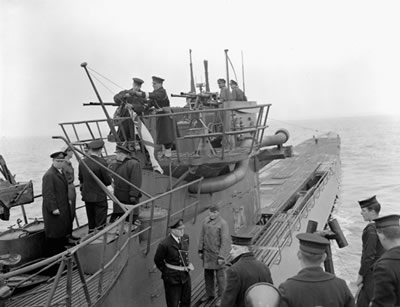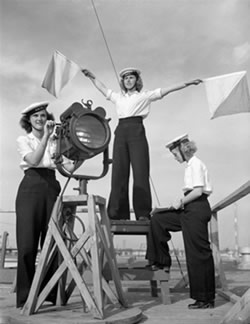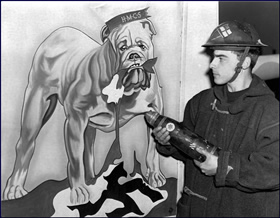Second World War
The RCN expanded greatly during the Second World War. From its modest beginnings of six ocean-going ships and 3,500 officers and men (both regular and reserve) at the outbreak of the war, it grew into a large and capable fighting force. This was important as the navy was immediately called on to help. In fact, the navy was the main thrust of Canada’s war effort in the first two years of the conflict as German U-boats again made cutting off Allied shipping a top priority and the Allied navies had to find a way to protect the merchant vessels crossing the Atlantic Ocean so supplies could reach Europe.
This “Battle of the Atlantic” was the longest and one of the most important campaigns of the Second World War — lasting from the first day of the war in 1939 until the last day of the war in Europe in 1945. Canada played a major role with the RCN assuming responsibility for escorting convoys in the northwest Atlantic — the only major theatre of the war to be commanded by Canadians. This battle also saw the Germans bring the war to our own shores. U-boats even penetrated deep into the Gulf of St. Lawrence and the St. Lawrence River.
It was a tough fight, but with courage and the adoption of new technology and tactics, Canada helped the Allies to victory in the Battle of the Atlantic. More than 25,000 merchant ships safely made it to their destination under Canadian escort, delivering approximately 165 million tons of vitally-needed supplies to Europe. The RCN sank or helped sink more than 30 U-boats, but at a steep price. The RCN lost 14 warships to enemy attack and another eight ships to accidents at sea during the Second World War, with approximately 2,000 losing their lives.
RCN ships also served in different ways during the war. They fought against the Japanese in the Pacific and took part in other kinds of military operations in the waters off Europe, like patrolling and mine sweeping in the English Channel and supporting Allied landings in Normandy, Sicily, mainland Italy and southern France.
At the end of the Second World War, Canada had one of the largest navies in the world with 95,000 men and women in uniform, and 434 commissioned vessels including cruisers, destroyers, frigates, corvettes and auxiliaries. It was an incredible growth that symbolizes the great contributions that Canadians made in the cause of peace and freedom during history’s largest war.
Did You Know?
Canadian women first served in the RCN during the Second World War. The Women’s Royal Canadian Navy Service (WRCNS) — whose members were commonly called “WRENs”, after the Women's Royal Navy — was launched in 1942 to recruit women to work in support roles in the navy so more men would be available for sea duties. WRENs did much of the same sort of work as men (except for serving at sea on warships), such as servicing anti-submarine equipment and aircraft, performing communications roles and working as drivers. By the end of the war there were about 6,000 women in the navy. Approximately 1,000 WRENs served overseas, many of them in Northern Ireland and Scotland, and more than 500 more served in Newfoundland (which was not yet a part of Canada).
Did You Know?
As a way to build crew morale and help create a sense of identity for each ship during the Second World War, most RCN corvettes (anti-submarine escort vessels) had their own unique emblem painted on their gun shields. Pride and creativity were key, so there were a wide variety of designs. The crew of HMCS Sackville had Donald Duck for an emblem, HMCS Summerside had Micky Mouse and HMCS Shawinigan had a bulldog tearing apart the Nazi flag.
Did You Know?
Lieutenant Robert Hampton Gray of the Royal Canadian Navy Volunteer Reserve earned a Victoria Cross (the highest award for military valour a Canadian can receive) in the closing days of the Second World War. Gray was serving as a pilot on the British aircraft carrier HMS Formidable in the Pacific on August 9, 1945 when he led a low-level attack against a Japanese destroyer. Braving heavy anti-aircraft fire and his plane in flames, he continued on until he dropped his bombs within 15 metres of the enemy ship. He scored a direct hit, causing it to sink immediately. Gray was killed — the last Canadian combat death of the Second World War and the last time a Canadian has been awarded the Victoria Cross.
Related Links
- Date modified:




